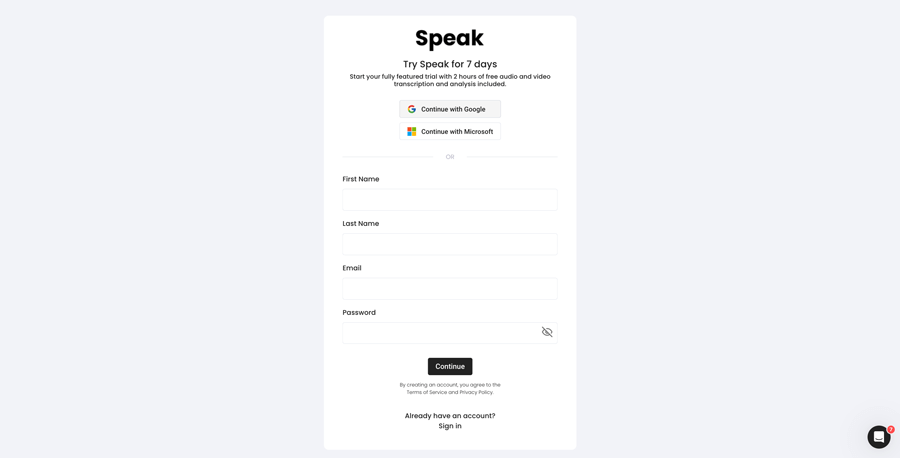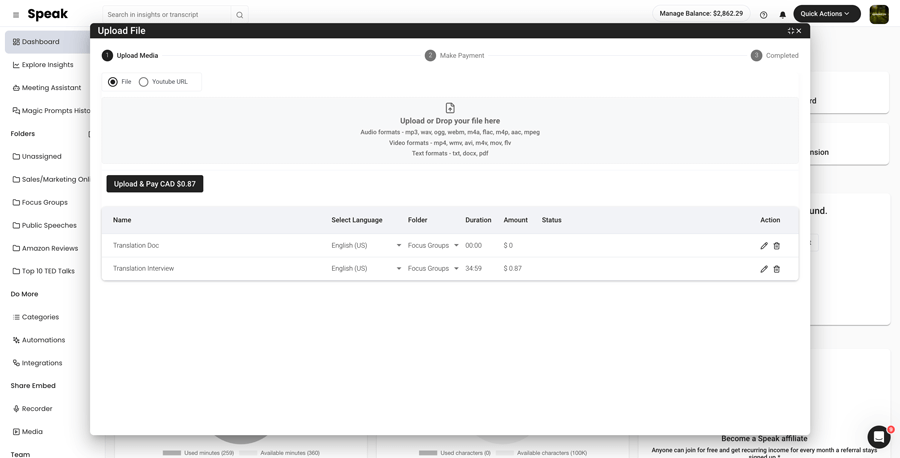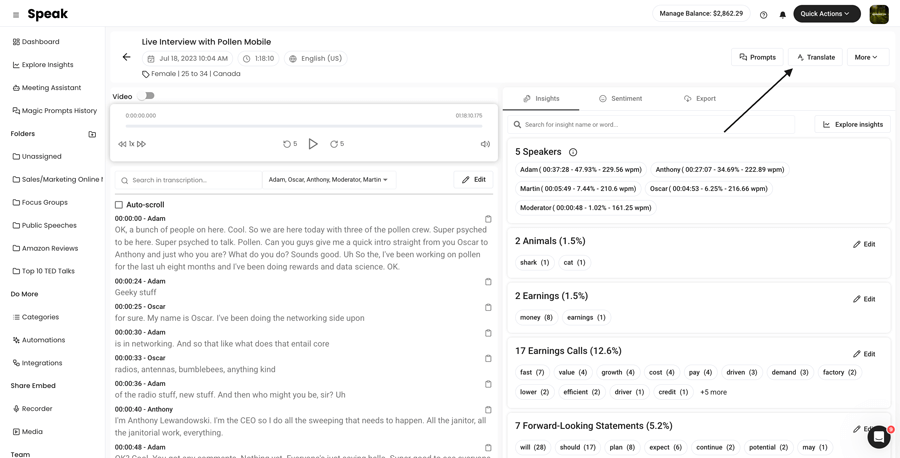How To Translate Japanese to Sinhala
Translating Japanese to Sinhala is super simple!

Step 1: Register for Speak
Register for Speak using this link.
Once you register, you can instantly begin translating your Japanese to Sinhala file(s).

Step 2: Upload Your Japanese file(s)
As soon as you log in, you will be redirected to the dashboard.
Once there, you can select the Quick Action "New Upload".
In Speak, you can seamlessly upload, transcribe and translate audio, video and text files all at once!

Step 3: Translate Your Japanese file(s) to Sinhala
Once the file is uploaded, simply visit your file and select "Translate".
If it is an audio and video file, Speak will ask you if you want to keep the speaker names and timestamps in the translation.
Want to translate many files at once? No problem!
You can view the files you want to automatically translate from Japanese to Sinhala from the folder level and instantly translate as many files as you need with our artificial intelligence translation in just a few clicks.

Step 4: That's It! View, Analyze, Modify & Export Your New Sinhala file(s)
Once the translation is done, you will be alerted and you will see a new document in the same folder your original file is in.
The file will be named the same but with a dash indicating that it is the translated version.
Need support with your Japanese translation?
We are always here and happy to help at Speak!
Just send us a message on live chat on the bottom right corner and we will ensure you are set up for success.
Interested in translating Japanese or other languages to different languages? View our entire list of supported translation languages here.
Automatic, accurate, instant AI translation from Japanese to Sinhala is here for you.
Register for Speak using this link and begin translating Japanese to Sinhala today.
Unlock New Opportunities: Translate Japanese to Sinhala with AI
In the digital age, where connectivity and communication transcend borders, the ability to understand and convey information in multiple languages is paramount. Speaking or translating Japanese to Sinhala, specifically, opens up a novel corridor of exchange between two rich cultures. This article explores the robust value generated through such translation, spotlighting the innovative solutions provided by Speak AI. Our technology, which encompasses AI-powered translation, aims to revolutionize how researchers and businesses engage across linguistic divides.
The Strategic Edge of AI-Powered Translation
In an era where time is of the essence, automated Japanese to Sinhala translation stands out as a cornerstone for efficiency. The advancement of Natural Language Processing (NLP) and AI technologies, as harnessed by Speak AI, offers unprecedented accuracy and speed. This leap in technology is not merely about translating text; it extends to translating audio and video content, opening vast vistas for content creators, businesses, and academic researchers.
Benefits of Japanese to Sinhala Automatic Translation
- Cost Efficiency: Automated translations significantly reduce the resources spent on manual translations, offering a cost-effective solution without compromising on quality.
- Time-Saving: With AI, hours of translation work can be condensed into mere minutes, accelerating project timelines and productivity.
- Enhanced Accuracy: Leveraging large language models, Speak AI's software ensures highly accurate translations, considering context and cultural nuances.
- Accessibility: Bridging language barriers, AI translation makes information accessible to a broader audience, facilitating global communication and understanding.
Specific Use Cases: Bridging Japanese and Sinhala
Consider the following scenarios where Japanese to Sinhala translation can be transformative:
For Researchers
Translating research papers, historical texts, or current publications from Japanese to Sinhala (and vice versa) can greatly benefit scholars. This not only enriches academic discourse but also fosters collaboration between Japanese and Sinhalese researchers and institutions.
For Businesses
Businesses aiming to expand into Japanese or Sinhalese markets find translation tools indispensable for product documentation, marketing material, and legal documents, ensuring clarity in communication and compliance with local regulations.
Japanese and Sinhala: A Tale of Two Languages
Understanding the significance of translating between Japanese and Sinhala requires a look into the languages' popularity, history, and unique characteristics.
Geographical Reach and Demographics
Japanese, primarily spoken in Japan, boasts approximately 128 million speakers. It's a language marked by its richness and complexity.
Sinhala, on the other hand, is the lingua franca of Sri Lanka, spoken by nearly 17 million people. It stands out for its unique script and phonetic expressions.
Fun Facts
Japanese and Sinhala share the distinction of having rich literary traditions and intricate scripts. Interestingly, Sinhala contains some words borrowed from Portuguese, Dutch, and English, showcasing a history of colonial interaction, whereas Japanese incorporates a significant number of loanwords from English and Chinese.
Linguistic Nuances
Despite their geographical separation, Japanese and Sinhala share common linguistic traits, such as the importance of formality levels in speech. However, their syntactic structures diverge significantly, with Japanese favoring a subject-object-verb (SOV) order, whereas Sinhala typically follows a subject-verb-object (SVO) pattern – akin to English.
Conclusion: Embrace the Future with Speak AI
The convergence of Japanese and Sinhala through AI translation is not just a technological marvel; it's a bridge connecting cultures, industries, and knowledge domains. With Speak AI's state-of-the-art tools, harnessing the power of AI translation becomes effortless, offering dynamic solutions for specialized needs. Our platform's capacity to translate text, audio, and video content with precision and speed ensures that no matter your goal, be it research expansion, market exploration, or cultural exchange, Speak AI stands ready to propel your endeavors into a global arena.
Engage with Speak AI today and be part of a community that is breaking language barriers and fostering a more interconnected world. For more insightful articles and to learn how our AI Meeting Assistant can transform your communication landscape, visit [Speak AI] – where innovation meets reliability, backed by a sterling 4.9 rating on G2 and a thriving user base of over 150K.
Join us in embracing the boundless possibilities that Japanese to Sinhala translation holds, powered by the unmatched precision and efficiency of Speak AI. Navigate the world's rich tapestry of languages and cultures with tools designed for the future – because when languages converge, opportunities emerge.
Translate Japanese To These Other Supported Languages:
- Translate Japanese-to-Albanian
- Translate Japanese-to-Amharic
- Translate Japanese-to-Arabic (Egypt)
- Translate Japanese-to-Arabic (Iraq)
- Translate Japanese-to-Arabic (Israel)
- Translate Japanese-to-Arabic (Jordan)
- Translate Japanese-to-Arabic (Kuwait)
- Translate Japanese-to-Arabic (Lebanon)
- Translate Japanese-to-Arabic (Oman)
- Translate Japanese-to-Arabic (Palestinian Authority)
- Translate Japanese-to-Arabic (Qatar)
- Translate Japanese-to-Arabic (Saudi Arabia)
- Translate Japanese-to-Arabic (Syrian Arab Republic)
- Translate Japanese-to-Arabic (United Arab Emirates)
- Translate Japanese-to-Arabic Modern Standard (Bahrain)
- Translate Japanese-to-Armenian
- Translate Japanese-to-Azerbaijani
- Translate Japanese-to-Bengali
- Translate Japanese-to-Bosnian
- Translate Japanese-to-Bulgarian
- Translate Japanese-to-Catalan
- Translate Japanese-to-Chinese (Cantonese, Traditional)
- Translate Japanese-to-Chinese (Simplified)
- Translate Japanese-to-Chinese (Traditional)
- Translate Japanese-to-Croatian
- Translate Japanese-to-Czech
- Translate Japanese-to-Danish
- Translate Japanese-to-Dari
- Translate Japanese-to-Dutch
- Translate Japanese-to-English
- Translate Japanese-to-English (Australia)
- Translate Japanese-to-English (India)
- Translate Japanese-to-English (Ireland)
- Translate Japanese-to-English (New Zealand)
- Translate Japanese-to-English (Scottish)
- Translate Japanese-to-English (South African)
- Translate Japanese-to-English (United Kingdom)
- Translate Japanese-to-English (United States)
- Translate Japanese-to-Estonian
- Translate Japanese-to-Farsi (Persian)
- Translate Japanese-to-Finnish
- Translate Japanese-to-French
- Translate Japanese-to-French (Canada)
- Translate Japanese-to-Georgian
- Translate Japanese-to-German
- Translate Japanese-to-German (Swiss)
- Translate Japanese-to-Greek
- Translate Japanese-to-Gujarati
- Translate Japanese-to-Haitian Creole
- Translate Japanese-to-Hausa
- Translate Japanese-to-Hebrew
- Translate Japanese-to-Hindi
- Translate Japanese-to-Hungarian
- Translate Japanese-to-Icelandic
- Translate Japanese-to-Indonesian
- Translate Japanese-to-Irish
- Translate Japanese-to-Italian
- Translate Japanese-to-Japanese
- Translate Japanese-to-Kannada
- Translate Japanese-to-Kazakh
- Translate Japanese-to-Korean
- Translate Japanese-to-Latvian
- Translate Japanese-to-Lithuanian
- Translate Japanese-to-Macedonian
- Translate Japanese-to-Malay
- Translate Japanese-to-Malayalam
- Translate Japanese-to-Maltese
- Translate Japanese-to-Marathi
- Translate Japanese-to-Mongolian
- Translate Japanese-to-Norwegian
- Translate Japanese-to-Pashto
- Translate Japanese-to-Persian
- Translate Japanese-to-Polish
- Translate Japanese-to-Portuguese
- Translate Japanese-to-Portuguese (Brazilian)
- Translate Japanese-to-Portuguese (Portugal)
- Translate Japanese-to-Punjabi
- Translate Japanese-to-Romanian
- Translate Japanese-to-Russian
- Translate Japanese-to-Serbian
- Translate Japanese-to-Sinhala
- Translate Japanese-to-Slovak
- Translate Japanese-to-Slovenian
- Translate Japanese-to-Somali
- Translate Japanese-to-Spanish
- Translate Japanese-to-Spanish (Mexico)
- Translate Japanese-to-Swahili
- Translate Japanese-to-Swedish
- Translate Japanese-to-Tamil
- Translate Japanese-to-Telugu
- Translate Japanese-to-Thai
- Translate Japanese-to-Turkish
- Translate Japanese-to-Ukrainian
- Translate Japanese-to-Urdu
- Translate Japanese-to-Uzbek
- Translate Japanese-to-Vietnamese
- Translate Japanese-to-Welsh



